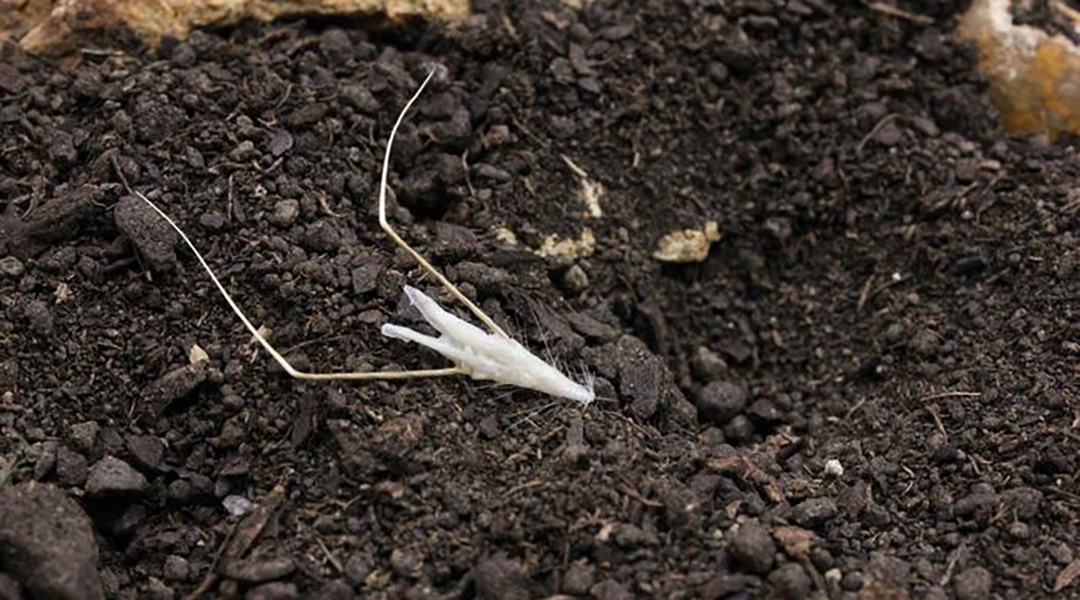Researchers often take inspiration from nature, but they are now taking it one step further with plant-robot hybrids. Based on the fruit of wild oats, these biohybrids are miniature machines that independently explore and dig into soil, and have the potential to aid in reforestation and precision agriculture, both on Earth or Mars.
Wild oats of the genus Avena are incredibly successful grasses. They have colonized the globe in part due to the ingenious design of its seed-carrying fruit. To disperse into new environments and ensure the seeds find a home in the soil, the fruits are designed to jump and dig. But they do so without a metabolism or muscles to move — instead they respond to humidity changes and accumulated elastic energy that propels them into their surroundings.
Consisting of a small seed package and two bristle-like appendages found on certain seeds called awns, the natural fruit is a mix of living and dead tissue. The spindly, thin awns, which protrude from the fruit, are made of dead tissue, and in humid or wet conditions, a section of cells at the base tilts, causing the awns on either side of the fruit to entangle.
This twisting stores elastic energy, which is eventually released, springing the fruit forward and into cracks in the soil where fine hairs along its side help to embed it.
Making the best of what nature has to offer
Bio-roboticists, like Isabella Fiorello, see the potential of this design for delivering fertilizers or seeds. However, rather than replicating the fruit and building a new actuator from scratch, she decided to use the awns themselves.
“For my use, it doesn’t make sense to [make] a new actuator because the natural system works much better,” she explained. Furthermore, the wild oats use of dead tissue makes it one of the few plant parts that can be removed and still function. “If you put [the awns] in water or if you change the humidity in the environment, they start rotating and working the same way,” she explained, “and so what I did was to recreate artificially only the capsule.”
Working with colleagues at the Italian Institute of Technology and the University of Freiburg, Fiorello created a sustainable capsule made from flour and cellulose, both of which are safe and biodegradable ingredients.
Using a reusable mold, the capsules were pressed into shape and contain the desired payload. Then the awns are attached and the biohybrid machines are ready to be deployed by hand or by drone.
Once on the ground, they behave just like wild oats and bounce around, finding cracks and crevices to burrow into. This natural strategy of the oats to find ideal places to germinate and grow could greatly improve projects, like reforestation of large areas, where soil quality is less than ideal. The miniature machines can then be reused or left to biodegrade at no risk to biodiversity or wildlife that may eat them.
A moonshot
Experimental tests with the biohybrids, now named Hybribots, showed they behaved in a comparable way to their all-natural counterparts in several soil conditions. Test of the torque generated by the awns and the force required for the robots to penetrate the soil were comparable to those of the natural system, showing these hybrids do behave like the natural oats in dirt, loam, and clay.
For this proof-of-concept, Fiorello had to remove the awns from the fruit and place them in the mold manually, but she is confident the entire manufacturing process could be automated and done cheaply. Sourcing wild oats is also not a problem as they are invasive abundant and a nuisance in many regions.
Fiorello and her group continue to work on biohybrids for cargo delivery not just in soil but in aquatic environments and even space. “I am thinking about using these robots for soil on the moon or soil on Mars,” she said.
Admittedly, this soil is not fertile, but Fiorello imagines designing a capsule with essential nutrients that would allow the seeds to grow within the robot after they’ve landed and dug into the extraterrestrial surface.
Reference: Isabella Fiorello, et al., A Biohybrid Self-Dispersing Miniature Machine Using Wild Oat Fruit Awns for Reforestation and Precision Agriculture, Advanced Materials (2024). DOI: 10.1002/adma.202313906
Feature image: HybriBot combines the oat fruit appendices with an artificial component. Credit: Istituto Italiano di Tecnologia/University of Freiburg

















